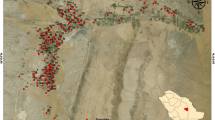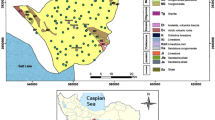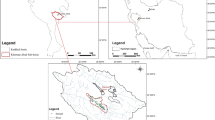Abstract
Geostatistical methods are one of the advanced techniques to interpolate groundwater quality data. Geostatistical interpolation techniques employ both the mathematical and the statistical properties of the measured points. Compiling the data distribution on spatial and temporal domain is of crucial importance in order to evaluate its quality and safety. The main purpose of this paper is to assess groundwater quality of Arak plain, Iran, by an unbiased interpolated method so called Kriging. Therefore, seven quality variables of Arak plain aquifer including TDS, SAR, EC, Na+, TH, Cl−, and SO4 2− have been analyzed, studied, and interpreted statistically and geostatistically. Utilized data in this study were collected from 97 water well samples in Arak plain, in 2012. After normalizing data, variogram as a geostatistical tool for defining spatial regression was calculated and experimental variograms have been plotted by GS+ software, then the best theoretical model was fitted to each variogram based on minimum RSS error. Cross validation was used to determine the accuracy of the estimated data. The uncertainty of the method could be well assessed via this method since the method not only gave the average error (around 0 in this study) but also gave the standard deviation of the estimations. Therefore, more than 3800 points were estimated by ordinary Kriging algorithm in places which have not been sampled. Finally, estimation maps of groundwater quality were prepared and map of estimation variance, EV, has been presented to assess the quality of estimation in each estimated point. Results showed that the Kriging method is more accurate than the traditional interpolation algorithms not honoring the spatial properties of the database.







Similar content being viewed by others
References
Sahebjalal, E. (2012). Application of geostatistical analysis for evaluating variation in groundwater characteristics. Journal of World Applied Sciences, 18(1), 135–141.
Diodato, N., & Ceccarelli, M. (2005). Interpolation processes using multivariate geostatistics for map** of climatological precipitation mean in the Sannio Mountains (southern Italy). Earth Surface Process, Landforms, 30(3), 259–268.
Istok, J. D., & Cooper, R. M. (1988). Geostatistics applied to groundwater pollution. III: global estimates. Journal of Environmental Engineering, 114(4), 915–928.
Jager, N. (1990). Hydrogeology and groundwater simulation. Lewis Publishers, 512 p.
Gupta, A.D., Jayakrishnan, R., Onta, P.R., & Ramnarong, V. (1995). Assessment of groundwater quality for the Bangkok aquifer system. IAHS Publications-Series of Proceedings and Reports-Intern Assoc Hydrological Sciences, 227, 3–13
D’Agostino, V., Greene, E. A., Passarella, G., & Vurro, M. (1998). Spatial and temporal study of nitrate concentration in groundwater by means of co-regionalization. Environmental Geology, 36(3–4), 285–295.
Pozdnyakova, L., & Zhang, R. (1999). Geostatistical analyses of soil salinity in a large field. Precision Agriculture, 1(2), 153–165.
Mouser, P.J., & Rizzo, D.M. (2004). Evaluation of geostatistics for combined hydrochemistry and microbial community fingerprinting at a waste disposal site. Critical Transitions in Water and Environmental Resources Management, pp 1–11.
Ahmed, S. (2002). Groundwater monitoring network design: application of geostatistics with a few case studies from a granitic aquifer in a semiarid region. Journal of Groundwater Hydrology, 2, 37–57.
Desbarats, A. J., Logan, C. E., Hinton, M. J., & Sharpe, D. R. (2002). On the Kriging of water table elevations using collateral information from a digital elevation model. Journal of Hydrology, 255(1), 25–38.
Amini, M., Khadi, H., & Fathianpour, N. (2002). Comparison of Kriging and co-Kriging methods for estimating Cl-concentration of soil. Iranian Journal of Agricultural Science (In Persian), 33(4), 741–748.
Gaus, I., Kinniburgh, D. G., Talbot, J. C., & Webster, R. (2003). Geostatistical analysis of arsenic concentration in groundwater in Bangladesh using disjunctive kriging. Journal of Environmental Geology, 44(8), 939–948.
He, J.Y., & Jia, X. (2004). ArcGIS geostatistical analyst application in assessment of MTBE contamination. In Proceedings of ESRI User Conference 2004.
Finke, P. A., Brus, D. J., Bierkens, M. F. P., Hoogland, T., Knotters, M., & De Vries, F. (2004). Map** groundwater dynamics using multiple sources of exhaustive high resolution data. Geoderma, 123(1), 23–39.
Sarangi, A., Madramootoo, C. A., Enright, P., & Chandrasekharan, H. (2005). Prediction of spatial variability of phosphorous over the St-esprit watershed. Journal of Water, Air, & Soil Pollution, 168(1–4), 267–288.
Barca, E., & Passarella, G. (2008). Spatial evaluation of the risk of groundwater quality degradation. A comparison between disjunctive Kriging and geostatistical simulation. Journal of Environmental Monitoring & Assessment, 137(1–3), 261–273.
Mehrjardi, R. T., Jahromi, M. Z., Mahmoudi, S., & Heidari, A. (2008). Spatial distribution of groundwater quality with geostatistics (case study: Yazd- Ardakan Plain). Journal of World Applied Sciences, 4, 9–17.
Webster, R., & Oliver, M. A. (2001). Geostatistics for environmental scientists (pp. 225–226). Brisbane: Wiley.
Bohling, G. (2005). Introduction to geostatistics and variogram analysis. Kansas Geological Survey, 20 p.
Chappell, A., Heritage, G. L., Fuller, I. C., Large, A. R., & Milan, D. J. (2003). Geostatistical analysis of ground-survey elevation data to elucidate spatial and temporal river channel change. Earth Surface Processes & Landforms, 28(4), 349–370.
Gundogdu, K. S., & Guney, I. (2007). Spatial analyses of groundwater levels using universal Kriging. Journal of Earth System Science, 116(1), 49–55.
Sarangi, A., Cox, C. A., & Madramootoo, C. A. (2005). Geostatistical methods for prediction of spatial variability of rainfall in a mountainous region. Transactions of ASAE, 48(3), 943–954.
Kitanidis, P. K. (1997). Introduction to geostatistics: applications in hydrogeology. California: Cambridge University Press.
Gong, G., Mattevada, S., & O’Bryant, S. E. (2014). Comparison of the accuracy of kriging and IDW interpolations in estimating groundwater arsenic concentrations in Texas. Journal of Environmental Research, 130, 59–69.
Fathianpour, N., Darabi, M., Maghsoudi, S., & Sartaj, M. (2012). Estimation comparison of nitrate concentration in Arak plain aquifer using neural network and local multivariate regression. 16th Meeting of the Geological Society of Iran.
Mohammadi, G. M., Ebrahimi, K., & Araghinejad, S. (2011). Groundwater quantity and quality evaluation: a case study for Saveh and Arak aquifers. Journal of Soil & Water (Agricultural Science), 21(2), 93–108.
Howarth, R. J., & Earle, S. A. M. (1979). Application of a generalized power transformation to geochemical data. Journal of the International Association for Mathematical Geology, 11(1), 45–62.
Matheron, G., (1971). The theory of regionalized variables and its applications: Fontainebleau, Centre de Morphologie Mathématique de Fontainebleau, 211 p.
Sajil Kumar, P. J., Jegathambal, P., & James, E. J. (2011). Multivariate and geostatistical analysis of groundwater quality in Palar river basin. International Journal of Geology, 5, 108–119.
Lin, Y. P., Tan, Y. C., & Rouhani, S. (2001). Identifying spatial characteristics of transmissivity using simulated annealing and kriging methods. Journal of Environmental Geology, 41, 200–208.
Rogerson, P. A., Delmelle, E., Batta, R., Akella, M., Blatt, A., & Wilson, G. (2004). Optimal sampling design for variables with varying spatial importance. Journal of Geographical Analysis, 36(2), 177–194.
De Marsily, M. (1986). Quantitative hydrogeology; groundwater hydrology for engineers. Academic Press.
Theodossiou, N., & Latinopoulos, P. (2006). Evaluation and optimisation of groundwater observation networks using the Kriging methodology. Journal of Environmental Modeling & Software, 21(7), 991–1000.
Bailey, T., & Gatrell, A. C. (1995). Interactive spatial data analysis. Essex: Addison Wesley Longman Limited.
Isaaks, E. H., & Srivastava, R. M. (1989). An introduction to applied geostatistics. New York: Oxford University Press.
Journel, A. G., & Huijbregts, C. J. (1978). Mining geostatistics (p. 600). Orlando: Academic Press, New York.
Goovaerts, P. (1997). Geostatistics for natural resources evaluation (p. 483). New York: Oxford University Press.
Journel, A.G. (1989). In: Fundamentals of geostatistics in five lessons, short course in geology. American Geophysical Union, 8, 10 p.
Marinoni, O. (2003). Improving geological models using a combined ordinary–indicator kriging approach. Journal of Engineering Geology, 69(1), 37–45.
Deutsch, C. V., & Journel, A. G. (1998). GSLIB: geostatistical software library and user’s guide. Second edition (p. 369). New York: Oxford University Press.
Draper, N.R., & Smith, H. (1998). Applied regression analysis (3rd ed.). Wiley. ISBN 0-471-17082-8.
Kerry, R., & Oliver, M. A. (2007). Determining the effect of asymmetric data on the variogram. II. Outliers. Journal of Computers & Geosciences, 33(10), 1233–1260.
Lark, R. M. (2000). A comparison of some robust estimators of the variogram for use in soil survey. European Journal of Soil Science, 51(1), 137–157.
Clayton, V., & Journel, A.G. (1998). GSLIB-geostatistical software library and user’s guide. Technometrics.
Jones, D. R., Schonlau, M., & Welch, W. J. (1998). Efficient global optimization of expensive black-box functions. Journal of Global Optimization, 13(4), 455–492.
Boukouvala, F., & Ierapetritou, M. G. (2012). Feasibility analysis of black-box processes using an adaptive sampling Kriging-based method. Computers & Chemical Engineering, 36(10), 358–368.
Author information
Authors and Affiliations
Corresponding author
Rights and permissions
About this article
Cite this article
Jalali, M., Karami, S. & Marj, A.F. Geostatistical Evaluation of Spatial Variation Related to Groundwater Quality Database: Case Study for Arak Plain Aquifer, Iran. Environ Model Assess 21, 707–719 (2016). https://doi.org/10.1007/s10666-016-9506-6
Received:
Accepted:
Published:
Issue Date:
DOI: https://doi.org/10.1007/s10666-016-9506-6




